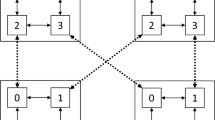Abstract
Optical transpose interconnection system (OTIS) is an optoelectronic architecture that promises to be a great choice for future-generation parallel systems. OTIS combines the advantages of electronic and optical links, where electronic links are used for short distances which require low material cost, and optical links are used for long distances which provide high speed network with low power consumption. Taking into account the advantageous characteristics of OTIS and based on the attractive properties of hyper hexa-cell (HHC) interconnection topology from low diameter and good minimum node degree, this paper introduces a new optoelectronic architecture referred to as OTIS hyper hexa-cell (OHHC). This paper also provides an evaluation and a comparison of the new topology with OTIS-mesh in terms of the following topological properties: size, diameter, maximum and minimum node degree, bisection width, total cost and optical cost. The results of this study proved the excellence of the proposed OHHC over OTIS-mesh in terms of diameter, minimum node degree, bisection width, and optical cost.
Similar content being viewed by others
References
El-Rewini H, Abd-El-Barr M (2005) Advanced computer architecture and parallel processing. Wiley, New York
Grama A, Gupta A, Karypis G, Kumar V (2003) Introduction to parallel computing. Addison Wesley, Reading
Patterson D, Hennessy J (2009) Computer organization and design: the hardware/software interface. Morgan Kaufmann, Boston
Chen Y-J, Horng S-J (1997) Medial axis transform on mesh-connected computers with hyperbus broadcasting. Computing 59(2): 95–114
Verdoscia L, Vaccaro R (1999) An adaptive routing algorithm for WK-recursive topologies. Computing 63(2): 171–184
Marsden G, Marchand P, Harvey P, Esener S (1993) Optical transpose interconnection system architecture. Opt Lett 18(13): 1083–1085
Zane F, Marchand P, Paturi R, Esener S (2000) Scalable network architectures using the optical transpose interconnection system (OTIS). J Parallel Distrib Comput 60(5): 521–538
Day K, Al-Ayyoub A (2002) Topological properties of OTIS-networks. IEEE Trans Parallel Distrib Syst 13(4): 359–366
Parhami B (2005) Swapped interconnection networks: topological, performance, and robustness attributes. J Parallel Distrib Comput 65(11): 1443–1452
Coudert D, Ferreira A, Muñoz X (2000) Topologies for optical interconnection networks based on the optical transpose interconnection system. Appl Opt 39(17): 2965–2974
Melhem R (2007) Low diameter interconnections for routing in high-performance parallel systems. IEEE Trans Comput 56(4): 502–510
Sahni S, Wang C-F (1997) BPC permutations on the OTIS-mesh optoelectronic computer. In: Proc 4th int conf on massively parallel processing using optical interconnections (MPPOI’97), Montreal, Canada, 22–24 June, pp 130–135
Hashemi-Najafabadi H, Sarbazi-Azad H (2005) An empirical comparison of OTIS-mesh and OTIS-hypercube multicomputer systems under deterministic routing. In: Proc 19th IEEE int parallel and distributed processing symposium (IPDPS’05), Washington, DC, USA, 4–8 April, p 262a
Rajasekeran S, Sahni S (1998) Randomized routing, selection, and sorting on the OTIS-mesh. IEEE Trans Parallel Distrib Syst 9(9): 833–840
Lucas K, Jana P (2010) Sorting and routing on OTIS-mesh of trees. Parallel Process Lett 20(2): 145–154
Lucas K (2010) Parallel enumeration sort on OTIS-hypercube. IC3 (1):21–31
Lucas K (2009) Parallel algorithm for sorting on OTIS-ring of computer. In: Proc of the 2nd Bangalore annual compute conference (COMPUTE ’09), Bangalore, India, 9–10 January. ACM, New York, pp 1–5
Lucas K, Jana P (2010) Parallel algorithms for finding polynomial roots on OTIS-torus. J Supercomput 54(2): 139–153
Lucas K, Mallick D, Jana P (2008) Parallel algorithm for conflict graph on OTIS-triangular array. In: Lecture notes in computer science, vol 4904. Springer, Heidelberg, pp 274–279
Lucas K (2009) Parallel algorithm for prefix computation on OTIS k-ary n-cube parallel computer. Int J Recent Trends Eng 1(1): 560–562
Wang C-F (1998) Algorithms for the OTIS optoelectronic computer. PhD thesis, Department of Computer Science, University of Florida, Florida, USA
Wang C-F, Sahni S (1998) Basic operations on the OTIS-mesh optoelectronic computer. IEEE Trans Parallel Distrib Syst 9(12): 1226–1236
Wang C-F, Sahni S (2001) Matrix multiplication on the OTIS-mesh optoelectronic computer. IEEE Trans Comput 50(7): 635–646
Mahafzah B, Jaradat B (2008) The load balancing problem in OTIS-hypercube interconnection networks. J Supercomput 46(3): 276–297
Zhao C, Xiao W, Parhami B (2009) Load-balancing on swapped or OTIS networks. J Parallel Distrib Comput 69(4): 389–399
Mahafzah B, Tahboub R, Tahboub O (2010) Performance evaluation of broadcast and global combine operations in all-port wormhole-routed OTIS-mesh interconnection networks. Clust Comput 13(1): 87–110
Hashemi-Najafabadi H, Sarbazi-Azad H (2007) Mathematical performance modelling of adaptive wormhole routing in optoelectronic hypercubes. J Parallel Distrib Comput 67(9): 967–980
Abdullah M, Abuelrub E, Mahafzah B (2011) The chained-cubic tree interconnection network. Int Arab J Inf Technol 8(3): 334–343
Day K, Tripathi A (1994) A comparative study of topological properties of hypercubes and star graphs. IEEE Trans Parallel Distrib Syst 5(1): 31–38
Latifi S, Zheng S-Q (1995) Determination of Hamiltonian cycles in cube-based networks using generalized gray codes. Comput Electr Eng 21(3): 189–199
Mahafzah B, Jaradat B (2010) The hybrid dynamic parallel scheduling algorithm for load balancing on chained-cubic tree interconnection networks. J Supercomput 52(3): 224–252
Saad Y, Schultz M (1988) Topological properties of hypercubes. IEEE Trans Comput 37(7): 867–872
Hayes J, Mudge T, Stout Q, Colley S, Palmer J (1986) Architectures of a hypercube supercomputer. In: Proc 1986 int conf on parallel processing (ICPP’86), PA, USA, August. IEEE Computer Society Press, pp 653–660
Author information
Authors and Affiliations
Corresponding author
Rights and permissions
About this article
Cite this article
Mahafzah, B.A., Sleit, A., Hamad, N.A. et al. The OTIS hyper hexa-cell optoelectronic architecture. Computing 94, 411–432 (2012). https://doi.org/10.1007/s00607-011-0177-5
Received:
Accepted:
Published:
Issue Date:
DOI: https://doi.org/10.1007/s00607-011-0177-5




